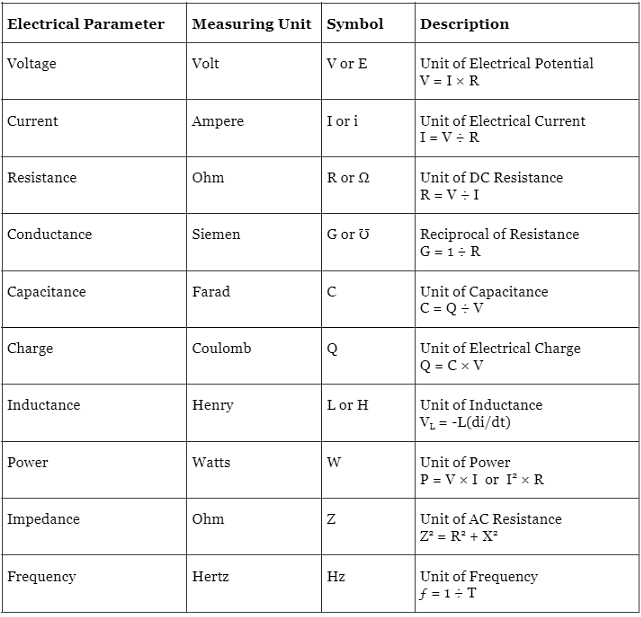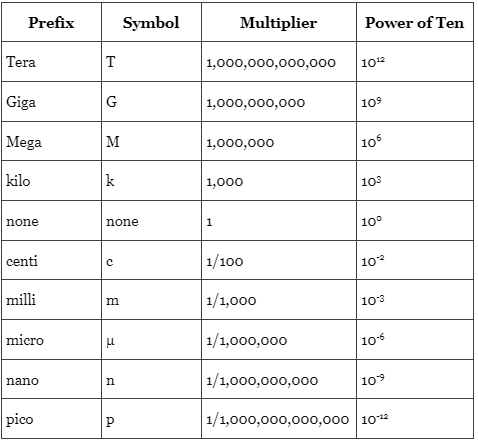Electrical Engineering (EE) Exam > Electrical Engineering (EE) Notes > Network Theory (Electric Circuits) > Electrical Units of Measurement
Electrical Units of Measurement | Network Theory (Electric Circuits) - Electrical Engineering (EE) PDF Download
| Table of contents |

|
| Introduction |

|
| Standard Electrical Units of Measure |

|
| Multiples and Sub-multiples |

|
| Some Other Units |

|
Introduction
- The standard electrical units of measure used for the expression of voltage, current and resistance are the Volt [ V ], Ampere [ A ] and Ohm [ Ω ] respectively.
- These electrical units of measurement are based on the International (metric) System, also known as the SI System with other commonly used electrical units being derived from SI base units.
- Sometimes in electrical or electronic circuits and systems it is necessary to use multiples or sub-multiples (fractions) of these standard electrical measuring units when the quantities being measured are very large or very small.

- The following table gives a list of some of the standard electrical units of measure used in electrical formulas and component values.
Standard Electrical Units of Measure

Question for Electrical Units of MeasurementTry yourself: Which unit is used to measure voltage in electrical circuits?View Solution
Multiples and Sub-multiples
- There is a huge range of values encountered in electrical and electronic engineering between a maximum value and a minimum value of a standard electrical unit. For example, resistance can be lower than 0.01Ω or higher than 1,000,000Ω.
- By using multiples and submultiple’s of the standard unit we can avoid having to write too many zero’s to define the position of the decimal point. The table below gives their names and abbreviations.

- So to display the units or multiples of units for either Resistance, Current or Voltage we would use as an example:
- 1kV = 1 kilo-volt – which is equal to 1,000 Volts.
- 1mA = 1 milli-amp – which is equal to one thousandths (1/1000) of an Ampere.
- 47kΩ = 47 kilo-ohms – which is equal to 47 thousand Ohms.
- 100uF = 100 micro-farads – which is equal to 100 millionths (100/1,000,000) of a Farad.
- 1kW = 1 kilo-watt – which is equal to 1,000 Watts.
- 1MHz = 1 mega-hertz – which is equal to one million Hertz.
- To convert from one prefix to another it is necessary to either multiply or divide by the difference between the two values. For example, convert 1MHz into kHz.
- Well we know from above that 1MHz is equal to one million (1,000,000) hertz and that 1kHz is equal to one thousand (1,000) hertz, so one 1MHz is one thousand times bigger than 1kHz. Then to convert Mega-hertz into Kilo-hertz we need to multiply mega-hertz by one thousand, as 1MHz is equal to 1000 kHz.
- Likewise, if we needed to convert kilo-hertz into mega-hertz we would need to divide by one thousand. A much simpler and quicker method would be to move the decimal point either left or right depending upon whether you need to multiply or divide.
Question for Electrical Units of MeasurementTry yourself:Convert 5 mA into micro-amperes.
View Solution
Some Other Units
As well as the “Standard” electrical units of measure shown above, other units are also used in electrical engineering to denote other values and quantities such as:
- Wh – The Watt-Hour, The amount of electrical energy consumed by a circuit over a period of time. Eg, a light bulb consumes one hundred watts of electrical power for one hour. It is commonly used in the form of: Wh (watt-hours), kWh (Kilowatt-hour) which is 1,000 watt-hours or MWh (Megawatt-hour) which is 1,000,000 watt-hours.
- dB – The Decibel, The decibel is a one tenth unit of the Bel (symbol B) and is used to represent gain either in voltage, current or power. It is a logarithmic unit expressed in dB and is commonly used to represent the ratio of input to output in amplifier, audio circuits or loudspeaker systems.
For example, the dB ratio of an input voltage (VIN) to an output voltage (VOUT) is expressed as 20log10 (Vout/Vin). The value in dB can be either positive (20dB) representing gain or negative (-20dB) representing loss with unity, ie input = output expressed as 0dB. - θ – Phase Angle, The Phase Angle is the difference in degrees between the voltage waveform and the current waveform having the same periodic time. It is a time difference or time shift and depending upon the circuit element can have a “leading” or “lagging” value. The phase angle of a waveform is measured in degrees or radians.
- ω – Angular Frequency, Another unit which is mainly used in a.c. circuits to represent the Phasor Relationship between two or more waveforms is called Angular Frequency, symbol ω. This is a rotational unit of angular frequency 2πƒ with units in radians per second, rads/s. The complete revolution of one cycle is 360 degrees or 2π, therefore, half a revolution is given as 180 degrees or π rad.
- τ – Time Constant, The Time Constant of an impedance circuit or linear first-order system is the time it takes for the output to reach 63.7% of its maximum or minimum output value when subjected to a Step Response input. It is a measure of reaction time.
The document Electrical Units of Measurement | Network Theory (Electric Circuits) - Electrical Engineering (EE) is a part of the Electrical Engineering (EE) Course Network Theory (Electric Circuits).
All you need of Electrical Engineering (EE) at this link: Electrical Engineering (EE)
|
73 videos|139 docs|62 tests
|
FAQs on Electrical Units of Measurement - Network Theory (Electric Circuits) - Electrical Engineering (EE)
| 1. What are the standard electrical units of measure? |  |
Ans. The standard electrical units of measure include volts (V) for voltage, amperes (A) for current, ohms (Ω) for resistance, watts (W) for power, and coulombs (C) for charge.
| 2. How are multiples and sub-multiples used in electrical units of measurement? |  |
Ans. Multiples and sub-multiples are used to represent values that are larger or smaller than the base unit. For example, kilo (k) represents a thousand times the base unit, while milli (m) represents one-thousandth of the base unit.
| 3. What are some other units commonly used in electrical measurements? |  |
Ans. Some other units commonly used in electrical measurements include ampere-hours (Ah) for battery capacity, hertz (Hz) for frequency, and farads (F) for capacitance.
| 4. How are electrical units of measurement applied in real-world scenarios? |  |
Ans. Electrical units of measurement are applied in real-world scenarios to design, analyze, and troubleshoot electrical systems such as circuits, power distribution networks, and electronic devices.
| 5. Why is it important to use standardized electrical units of measurement? |  |
Ans. Using standardized electrical units of measurement ensures consistency and accuracy in communication, design, and testing of electrical systems. It allows engineers and technicians to effectively collaborate and ensure safety and reliability in electrical applications.
Related Searches















